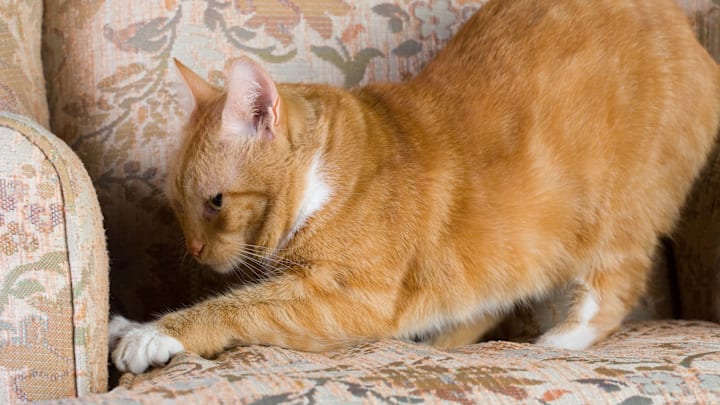The sound of tearing fabric is something many cat owners are all too familiar with. Perhaps you’ve watched as the legs of your favorite arm chair became shaggy with ripped threads, or spent hours trying to buff claw marks from a wooden floor.
Scratching comes with the territory of cat ownership. But it doesn’t mean you have to sacrifice your furniture to their sharply weaponed whims.
Why Cats Scratch Furniture

You can’t stop a cat from scratching—nor should you. “It’s an instinctual need. Their claws are a main form of defense, and they let them catch prey,” Dr. Marci Koski, a feline behavioral consultant and founder of Feline Behavior Solutions, tells Mental Floss. “They need to keep that weaponry finely tuned.”
Scratching does more than just keep their claws in tip-top shape. It’s a way for cats to mark their territory: Not only do the scratches show visual evidence of their presence, but they also leave behind the animal’s scent. It’s why you’ll often notice your kitty clawing at items in highly trafficked areas of your home like the family room or a doorway.
There are other reasons cats scratch, too. It’s a great way to stretch, and it also lets them work out excess energy after an exciting or tense interaction. If your pet’s in a really playful mood or is super excited to see you after you’ve been away all day, don’t be surprised if they interrupt their zoomies to claw at something.
How to Stop a Cat From Scratching Furniture

You may not be able to stop your cat from scratching, but you can try to prevent them from shredding your couch to bits or gouging the door frames so badly you have to forfeit your apartment’s security deposit.
When you’re trying to convince your kitty to scratch something other than your furniture, Koski suggests paying close attention to what they prefer to claw. If, for example, your cat tends to target the leg of a sofa, they probably like to scratch vertically; if they often opt for the rug, then look for something flat.
It’s smart to invest in a quality scratching post. A scratcher’s material is important, too, so try to notice if your pet shows a preference for anything like wood, carpet, or sisal.
The size of your scratcher matters as well. “Small, cheap scratchers are for people, not cats,” Koski says. “They aren’t stable or big enough. I tell people to get a big post on a non-skid surface.” She recommends the SmartCat Ultimate 32-in Sisal Cat Scratching Post, as it’s made of an appealing sisal material, and is tall and sturdy enough for cats to actually enjoy and feel secure using.
Where you actually put the scratching post is important, too. Cats usually claw things in highly trafficked areas, so tucking your scratching post into an unused corner of a rarely visited room won’t be very appealing to them.
Don’t force your pet to use the scratching post if they’re ignoring it. “Cats are independent,” Koski says. “They do things on their own time.” Coercing them into using a scratching post is likely to create a negative association with the object. Instead, use positive reinforcement. Koski suggests holding a treat or dangly toy above the post to encourage your cat to touch it. Once they voluntarily put their paws on it, there’s a good chance the texture will encourage them to start scratching it on their own.
If a scratching post still isn’t cutting it, you could try clicker training, or turn to a temporary solution such as covering the edges of your furniture with double-sided tape. The tape’s texture may dissuade some cats from clawing, but it isn’t a permanent solution, and it won’t work for every pet. “You have to be careful,” Koski cautions. “Some cats will try to eat the tape and some won’t care that it’s there.”
It may go without saying, but never declaw your cat. No matter how frustrating the furniture scratching may be, it never justifies putting your animal through a painful—and in some places, illegal—procedure.
